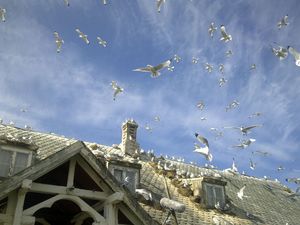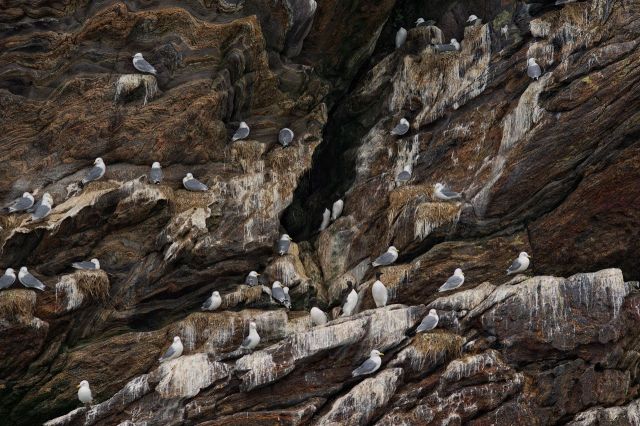
Live stream: soundscape_Rost_mix.mp3
Recording: The Kittiwakes of Kårøya (2012) - Elin Már Øyen Vister
Kårøya Kittiwake colony, Røst, Nordland
Elin Már Øyen Vister
Latitude: +67.5129316°
Longitude: +12.0663126°
You will be listening to a stream from Kårøya guesthouse on Kårøya, Røst, Norland, NO/Sápmi. The houses are home to what now has become an important breeding colony for the Kittiwakes (500+ pairs), since they abandoned Vedøya for good last summer.
In comparison, Vedøya bird mountain had a colony of 22.000 pairs of Kittwakes and 12.000 pairs of Guillemots in 1980+ many Shags, Puffins, Razorbills and more. Today the mountain is «silent». The Kittiwake is listed. As critically threatened on the Norwegian red list.
I / Elin Már, am an artist, composer, earth protector, and forager based on the island of Røst, 101 km off the coast of Nordland (Norway-Sápmii) into the Atlantic Ocean.
Links:
www.soundscaperost.com (under construction)
Soundscape Røst (2010-2021) is an ongoing art project, that listens to and documents the changing soundscapes of the Røst archipelago in Nordland, Northern Norway/Sápmi. Soundscape Røst listens to climate change: to the dramatic decline of the pelagic seabird populations and the silencing of the bird mountains as a result. Soundscape Røst listens to the acoustic realities of a marine land -and seascape over time and to nature-culture in an everlasting continuum of interdependency.
Soundscape Røst eavesdrops on a living coastal culture of a small community of 500 people or so, making their living mainly from the fisheries and infrastructure needed to sustain a small community where the average age is 60+. Røst interviews local people and seabird biologists/scientists gather archival material like literature/images/film/text describing the sonic environments of the seabird colonies throughout time, the bioacoustic experiments Swiss biologist/zoologist from Bern university did on Guillemots and their chicks on Vedøya in the 50ies until the 80ies led by professor Beat Tschanz (1920-2013), and to the ongoing Norwegian seabird research on Røst / Nykan nature reserve.
Soundscape Røst has, since it´s birth in August 2009, become an archive of Elin Már´s own field recordings and interviews, including a lexicon of "archival material" they have gathered from a variety of sources and archival institutions.
Soundscape Røst has so far given birth to an album trilogy of which the first album “Soundscape Røst- Spaces And Species Vol I” was released in 2012 (re-release June 2021 on Gruenrekorder) and the upcoming second album “Soundscape Røst- Spaces And Species Vol II" is being released this autumn on Gruenrekorder (DE) / Leynar Recordings.
Soundscape Røst is also a series of concerts, spatialized multi-channel sound installations, and performances.
The installation Soundscape Røst - The Listening Lounge (2012) was bought by the National Museum of Norway in 2020, and the 8 channel work Røster III (2015) was recently bought by NNKM- Northern Norwegian Art Museum.
A website offering a virtual sonic journey into the Soundscapes of the Røst archipelago and thorough information about Soundscape Røst is currently being built and will be ready in the summer of 2021.
About Røst
(Text is taken from Seapops website and edited by EMØV, April 2021)
Røst municipality (67° 30’ N 12° 00’ E) is a small collection of islands, more than 100 km west of Bodø and the Norwegian /Sámi mainland. With its extreme location, Røst is the southwesternmost part of Lofoten and Vestfjorden /Vestasjieggi, Norway-Sápmi´s largest archipelago and fjord area. The distinctive topography at Røst offers everything from open landscape to steep bird cliffs and covers a land area of 10.4 km2. The largest of the islands is the flat Røstlandet in the northeast, where the residents of the municipality live (515 inhabitants in 2018). There we also find the airport and Røstlandet Nature Reserve (established in 1997) with rich wetland areas. To the southeast lies the Røstøyan conservation area where the high bird islands lie in a row; Vedøy, Storfjellet, Ellefsnyken, Trenyken and Hernyken, with Skomvær lighthouse as the outermost point. The Nykan Nature Reserve (established in 2002) includes Ellefsnyken, Trenyken and Hernyken. Røst is surrounded by open sea, and the archipelago lies on a shallow plateau with hundreds of islets and skerries. The tidal range is 2-3 meters, creating strong tidal currents and difficult waters for boat travelers.
In addition to being in the center of the world-famous Lofoten/Lofuohta fishery of spawning cod in late winter, Røst is best known for its large population of breeding Atlantic puffins Fratercula arctica. At the end of the 1970s, Røst not only had Norway’s largest seabird colony, but also the world’s largest puffin colony with nearly 1.5 million breeding pairs. Unfortunately, the population has since declined dramatically as a result of food shortages and failed chick production. However, at Røst you can also find other breeding seabird species, including northern fulmar Fulmarus glacialis, storm petrel Hydrobates pelagicus, Leach’s storm petrel Oceanodroma Leucorhoa, European shag Phalacrocorax Aristotelis, common eider Somateria Mollissima, black-legged kittiwake Rissa Tridactyla, common guillemot Uria aalge, razorbill Alca torda, and black guillemot Cepphus grylle. Even today these populations are small compared to the puffin population, and many have declined.
There is no other site in Norway-Sápmi, north of the Polar Circle, where so many bird species have been registered as at Røst. The overall species list counts close to 300 species. Much of the reason for this lies in the extreme location and varied landscape. Seabirds come in close and the wetlands attract many wildfowl and waders. During autumn migration, Lofoten /Lofuohta acts a funnel that runs out in Røst. Due to the overall lack of shrubs and trees, the small areas of vegetation in people’s gardens act as magnets for many passerines. There they are easy to spot and more and more amateur ornithologists visit Røst in September-October to look for rarities.
Røst is first and foremost a fishing community, but during the seabird breeding season, fishing activity is low. The tourists visiting Røst during the summer are primarily interested in close encounters with the birdlife, but the rich stocks of cod, saithe and halibut also attract many sport fishers. There are daily boat trips along the bird cliffs and, if the weather allows it, a tour around Skomvær lighthouse is offered.
NINA Norwegian Institute for Nature Research - Seapop fieldwork
With its large bird cliffs and unique location, Røst is a natural choice as a key site. Research on seabirds has been carried out here since the 1950s, and at Røst we find the longest monitoring series on seabirds in Norway-Sápmi.
Research on seabirds at Røst started at the end of the 1950s, and it has been continued through a number of projects. This long period of research makes the knowledge of the seabird populations here much greater than from other places along the Norwegian coast. This applies especially to the puffin population, which has been the focus of the most comprehensive studies at Røst. Today the monitoring includes around 20 seabird species, of which 10 are key species in SEAPOP. The work is led by NINA and is based at the institute’s field station at Hernyken (67°26’ N 11°52’ E).
The first field station at Hernyken consisted of a 7 m2 primitive cabin with a dirt floor. It was built in the 1930s from an old wooden boat, which had been pulled ashore and turned upside down. When Svein Myrberget from “Statens Viltundersøkelser” from Ås started his research on puffins at Hernyken in 1964, he built a 10 m2 annex. This cabin served as a kitchen, bedroom, living room, and working area for the field workers for 45 years. It was not until 2009 that it was replaced by a modern, fully insulated cabin. The institute also has a building on Vedøya at its disposal, a two-story log cabin that was moved there from Røstlandet at the end of the 1950s. It was used by Swiss professor Beat Tschanz and his students that conducted behavioral research on seabirds for 25 years.
Here are some links to some archival films from Røst:
Lomvi på Røst
Skjær og Nyker på UtTrøst
Per Høst- Sommer på Røst
Om Lundefangst på Røst på NRK TV
